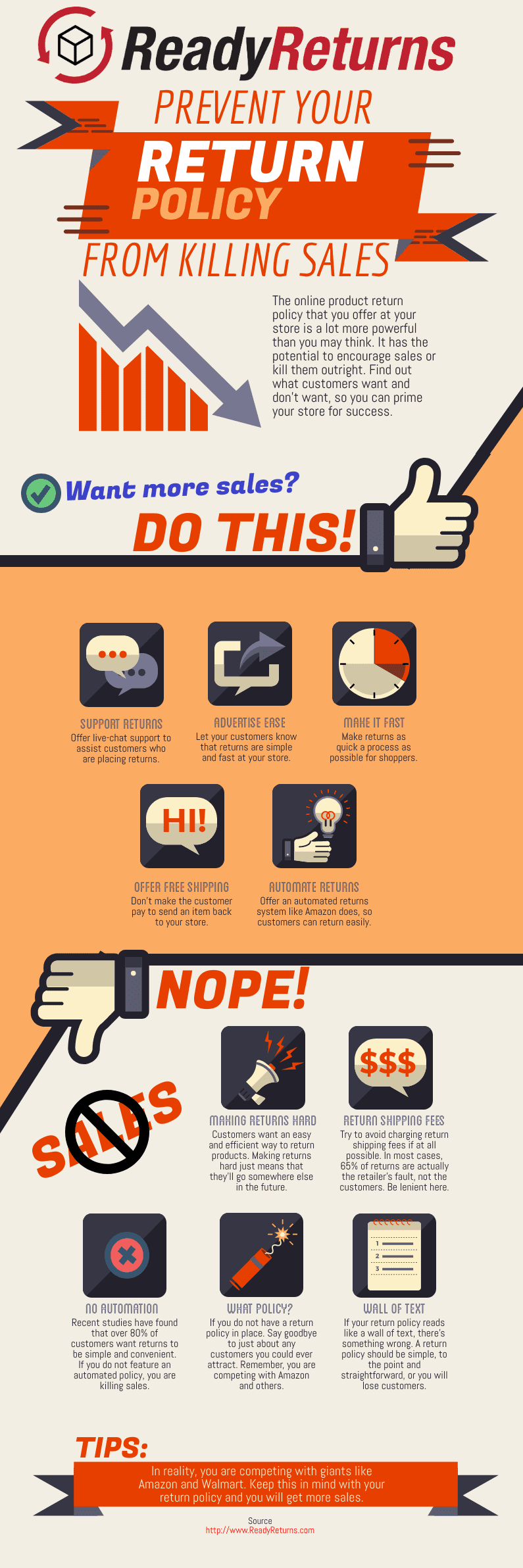Online Product Returns Have More Than Doubled in Past 3 Years

The good news is that if you’re an online retailer, there are many ways you can improve your returns policy and reduce your return rates. In this guide, I’ll shed light on the most practical ones.
Why Are Products Being Returned? What the Statistics Say
Shoppers return between 15-40% of what they buy online. According to online shoppers, the top reasons are:
- Not being satisfied with the purchase
- Finding a better price elsewhere
- Needing to return an item that didn’t fit or suit them properly
- The product wasn’t as described online
So what does this tell us? That it’s mostly about buyers’ expectations not being met.
How to Improve Your Returns Policy
Having a solid online return policy is the first step towards reducing online product returns. Here are some online retailer best practices.
Include a Clear Online Return Policy
Your online returns and exchange policy isn’t something you want your customers to stumble upon. Instead, it should be clearly stated on the product page or checkout process so that buyers can see it with ease. Your online shopper should be able to determine if they can exchange online products online or receive a refund on their purchase before they click the “buy” button.
Also, be clear about your policy itself. If you accept or don’t accept something, your online customers need to be aware of that too. For example, you don’t want them to think they can return an item when you only accept exchanges in reality.
Make Sure You Accept Returns
This is the most obvious advice, but surprisingly, there are still online retailers that don’t allow customers to return items. Make sure they can! A good rule of thumb is to let them exchange or get a refund within 30 days of purchase.
Accept Online Product Exchanges
If your customers can’t return products, then it’s best to offer online product exchanges at least. This will give them an option to try a different size or color of a specific item, often leading them not to return the product at all.
While you may not want to lose money on online returns, it’s better than losing a customer because they didn’t have the option of online product exchanges and had to pay return shipping costs themselves.
Provide Hassle-Free Online Returns
While most online retailers accept product returns, many give customers a hard time during the process as if it’s a punishment.
Instead, you want to make it easy for customers by offering free online product return shipping and accepting the original payment method. Also, inform your online shoppers on how to initiate an online return in detail.
Give Online Shoppers Personalized Options
Offer your customers different ways of returning their items depending on what kind of online shopper they are.
For instance, if they have a busy schedule and want to drop their online product return off at your store location, let them! Or maybe you can offer an online self-service returns portal where online shoppers can print out a shipping label or track the status of their online product return themselves without needing assistance from customer service.
This will give them control over the entire online return process.
How to Reduce Product Return Rates
Now, that was all about making the return process better for customers, but how can you reduce the rate of online product returns altogether? Here are some ideas.
Give Buyers a Realistic Idea of What They Should Expect
Online shoppers will have a better online shopping experience if you give them realistic expectations about an item. If your online product descriptions are detailed and accurate, online shoppers won’t feel the need to return items because they didn’t meet their expectations!
Moreover, ensure that every product has high-quality images, preferably from each angle. Having one blurry photo doesn’t help with establishing reasonable expectations for a product.
Create Size Guides and Fitting Tools
To help reduce online product returns due to sizing issues, create a size guide that’s easy to read and understand for each item and use tools like virtual try-ons so shoppers can see how clothes look on a body before purchasing.
Enable Product Reviews
Online shoppers trust online product reviews more than anything else! So make sure you give your customers the chance to review products after their purchase (and even reward them for it) so that other online customers can read about what online shoppers like them thought of the same items.
Be There During the Process of Online Shopping
You shouldn’t leave online shoppers hanging if they need help with online shopping. Instead, make it easy for them by offering customer service at all hours of the day via phone, email, or even live chatting.
Easily accessible touchpoints for customers can make all the difference because they provide customers with the opportunity to reach out with product-related questions, even after they buy the product.
The Bottom Line
As online retailers, it’s only normal to be concerned about product returns because they can be costly, so you want to reduce them to the minimum. But online returns aren’t only about the cost; there are other factors to consider, such as customer satisfaction and reputation.
With the support of this guide, you should now be well on your way to making online returns as easy and swift as possible for your customers while working to reduce your online product returns rate significantly!

What You Should Do Now
Here are 3 ways ReadyReturns can help you deliver amazing return experiences that eliminate prepaid labels and boxes, delight customers, and protect your margins:
Schedule a Demo – See how ReadyReturns turns product returns into your competitive advantage with “Amazon-like” returns and cost-saving features.
Start Your Free Trial of ReadyReturns (No CC Required) – Set up in minutes. Instantly offer QR code returns, product exchanges, and custom return rules that turn frustrated customers into repeat buyers.
Try ReadyCloud at No Cost – Why manage shipping and returns separately? Get ReadyShipper X, ReadyReturns, and more in one unified platform for seamless fulfillment and order management.
Share On:








